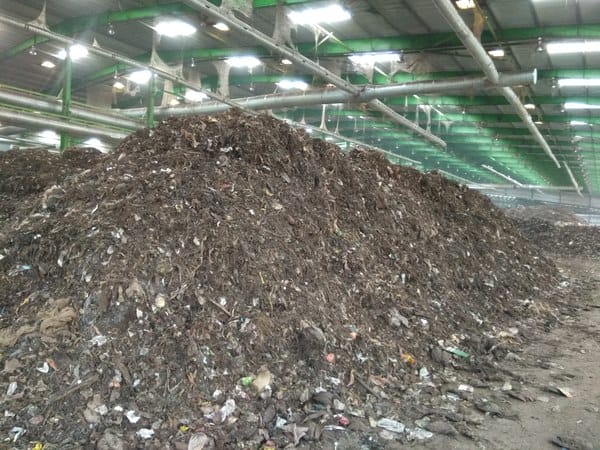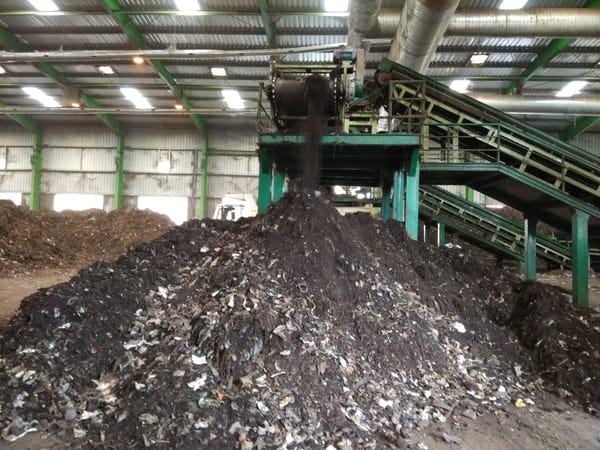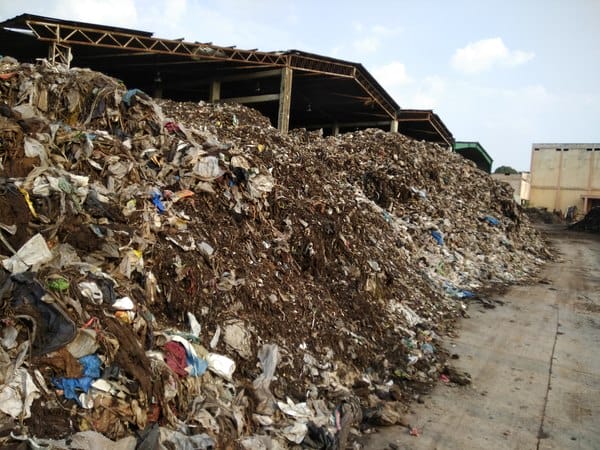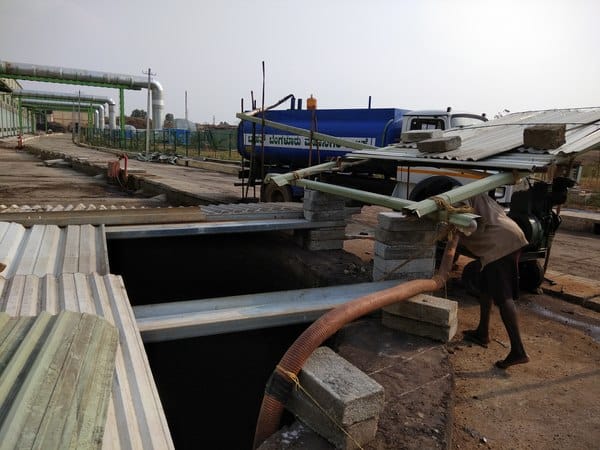In the first part of the series on composting plant in HSR Layout, we shared the citizens’ view on Karnataka Compost Development Corporation (KCDC) plant in Kudlu. In the second part, I talked about what I saw in the plant. In this last part, I’ll be getting into the intricacies of what is going on.
Every time the residents arose in protest over the functioning of Karnataka Compost Development Corporation (KCDC) plant in Kudlu, the KCDC and the BBMP would temporarily mollify them with assurances. BBMP would talk of introducing solutions for odour control or shifting the waste elsewhere, and the residents would call off their protests.

Mounds of waste dumped at the KCDC waste processing unit in Kudlu. Pic: Akshatha M
The BBMP has been looking after the functioning of KCDC following a High Court order in 2015 that asked the BBMP to take over KCDC. With none of the odour control systems yielding any result, the BBMP recently came up with yet another solution. This time it was decided to use the consulting service of a solid waste management expert from Mumbai to fix the waste issues in the KCDC unit. The decision was taken by the BBMP Commissioner, and according to some BBMP officials it was decided at the behest of Almitra H Patel, member of BBMP’s Solid Waste Management Expert Committee.
But after spending lakhs of rupees on the consultant (according to sources the bill amount was close to Rs 40 lakh), that exercise also has now gone futile.
The consultant who temporarily took responsibility of KCDC’s waste processing is Raaginii Jaain. Raaginii is a freelance consultant for waste management with more than 30 years of experience in SWM and recycling of non-degradable materials. Her Linkedin profile says that she has been an environment and solid waste management consultant to various states and urban local bodies including Rajasthan, Uttaranchal and Mumbai. She is also the founder of Gitanjali Envirotech, which has been listed in Almitra H Patel’s website as a bio-culture service provider and supplier.
Raaginii Jaain’s team (comprising two men who were monitoring the work) took charge of the waste processing monitoring and managing work at KCDC on February 7th. She was given three months to streamline the waste processing system in the compost plant. But her team stopped their work at the plant two weeks ago – a month before the deadline.
“Reduced leachate with bioculture”
When I spoke to Raaginii Jaiin after two months of her team taking charge of the plant (when her team was still at work), she claimed to have reduced the leachate and stench to a large extent with the help of a bio-culture that she has been using at KCDC.
She said she has brought positive change in the KCDC plant where the waste was earlier mismanaged. “Earlier they used to spray lemongrass oil on the waste that was ready for windrow processing. I replaced it with bio-culture. Lemongrass oil is an edible oil and it’s highly expensive. Therefore, the KCDC was not using the pure lemongrass oil, but was using the essence of the oil mixed with a chemical. Lemongrass essence is of no use in leachate and odour control. I replaced it with bio-culture,” Raaginii Jaain told me.

A portion of waste that is brought down for windrow processing. Pic: Akshatha M
As a result, she says leachate generation drastically reduced. “When we initially came to the KCDC, the entire shed was flooded with leachate. The leachate tank used to be full with yellow foam covering it and it was slowly flowing to the lake through the drain. I brought it down to half and it is pure leachate. It doesn’t flow to Somasundarapalya lake anymore. We have sent 12 lakh litres of leachate to the BWSSB’s sewage treatment plants in the first one and a half months,” she explained.
So what did Raaginii Jaain’s team do with the waste?
Apart from processing the new waste (KCDC now receives around 100-130 tons of wet waste everyday), the team also claimed to have initiated the processing of old waste which has been lying there for three years. Around 16,000-18,000 tonnes of old waste (mixed waste) is dumped in the plant premises.
“Before we came, they (KCDC workers) used to follow faulty waste processing method. They used to cover the new waste with a layer of old waste, apparently to reduce the smell. They would pour 10,000 litres of water everyday which was not at all necessary. We used just 500 litres of water along with the culture and this has reduced the leachate formation,” Raaginii explained.
A consultancy that drew flak
KCDC, as instructed by Raaginii, began processing both fresh and old waste. According to her, they started the windrow processing of fresh and old waste in a scientific manner and the volume of fresh waste went down by 40 per cent. “During the initial few weeks, we made space for the garbage and then began the windrow processing,” she added.

Waste processing in progress at KCDC. Pic: Akshatha M
When her team was still at work in KCDC, she told me that she was ready to guide and help BBMP in waste processing, even after her three months tenure, if the BBMP is interested.
But bringing Raaginii Jaain’s expertise to the KCDC drew severe criticism. The citizen groups who have been vocal against the KCDC waste processing plant, had also raised their voice against Raaginii Jaain.
Kavitha Reddy, a resident of HSR Layout and who has spearheaded the protests against KCDC, has been critical of the expert committee’s recommendations and of appointing Raaginii Jaain as the consultant. When we asked specific objections about KCDC, Kavitha Reddy wrote that public money was wasted and looted every single day in the name of waste processing, at KCDC.
“We want the KCDC Kudlu unit to be shut and we will not settle for anything less, it’s high time GoK stops applying lipstick on a pig and looks at different methods for waste processing,” she had said.
KCDC not happy with consultancy for processing
But it’s not just the residents who were unhappy about the new consultant guiding the KCDC. The KCDC Chairman and the staff too were disgruntled over the new developments. KCDC Chairman K Kenche Gowda says that he was not at all happy with the work of Raaginii Jaain and her team which he had also conveyed to the Chief Minister.
“Before the arrival of the expert’s team, the KCDC plant was functioning totally fine. There was not much stench emanating from the plant. It was only after they started monitoring the work that there was stench and residents began protesting. And the quantity of waste processing was reduced to 50 tons per day” he says, contradicting Raaginii’s claims.

Old waste (most of which is mixed) is dumped outside the processing shed in KCDC. Pic: Akshatha M
What has made the KCDC Chairman angry? The Chairman says the appointment of Raaginii Jaain as the consultant was not transparent. “The BBMP Commissioner asked her to provide her service to KCDC. But nothing has been on paper. There was no agreement between two parties. I have learnt that she demanded Rs 40 lakh from the BBMP for her work. Why waste money on something that will not help KCDC?” he asks. I could not independently ascertain this, and Raaginii refused to comment on her fees.
The Chairman adds that he asked his people to follow the same old method of waste processing and not allow Raaginii Jaain’s team to work in KCDC.
Following this, by the second week of April, Raaginii’s team stopped working at the plant. According to sources, the waste processing work was stopped due to breaking down of machines. Several machines including 60 mm microbial filtering machine and earthmovers got either punctured or broken down mysteriously. Raaginii Jaain’s team members claimed they were not aware of how the machines became defunct suddenly.
Soon the team left the premises.
‘Managing windrows the only solution’
Almitra Patel who advised BBMP to call Raaginii Jaain to KCDC, says that she was happy with the method that Jaain and her team demonstrated at KCDC.
Almitra adds, “Usable space was created by removing twelve lakh litres of leachate from inside the shed and two mounds of unturned wet waste reaching the roof were brought down. Huge piles of old mixed waste were briefly moved outside to windrows to dry out for proper processing. 150-200 tonnes of well-segregated fresh waste was unloaded inside the plant daily in 2 meter high windrows and sprayed with leachate-control composting bioculture,” She insists the situation was under control, with no stench emanating from the plant until end March 2017.”
Thereafter Jaain stopped all work at KCDC. “Now bad practices are back again, piling the waste very high and covering well-segregated wet waste with untreated old mixed waste. This has already caused citizens to complain of renewed stench since 10 days,” claims Almitra.

Leachate is removed from a tank and is transferred to a tanker to be set to BWSSB’s sewage treatment plant. Pic: Akshatha M
I asked her about the residents’ demand for the closure of KCDC. Almitra says closing it down is not an option or a solution. She explains, “Large scale composting can be stopped only if home and ward level composting takes place. Unless decentralised waste processing takes place, you cannot close down the big plants,” she adds. She claims that Raaginii Jain’s team has shown the KCDC what good management is like and it is up to them to decide if they want to adopt it or not, continue her services or not. “Successful windrow management is the only solution, and Raaginii Jaain had streamlined it in KCDC,” she told me.
The deadlock continues
On BBMP’s part, Joint Commissioner for Solid Waste Management Sarfaraz Khan told me that after trying out several methods of leachate and odour control, they are now using the foolproof solution provided by Almitra Patel. “Though bio-filter has been installed, it is not fully effective yet. Our first priority is odour control. Almitra Patel has given us a good solution through Raaginii Jaain. I believe there is nothing wrong in trying it out. We will follow the suggestions of Raaginii Jain even after her team leaves the plant,” he had said in March. He was not available for comments when I tried contacting him after Raaginii Jaiin’s departure.
When I visited the KCDC plant again on April 20th, a month after my previous visit, the windrow processing was not happening. The leachate was under control, but the piles of waste were reaching the roof. When asked why the piles, a staff at the KCDC said that it was due to the ducting work for biofilters inside shed. “We will bring it down and start the windrow soon,” he said.
With this, the KCDC is back to its old system of waste processing using lemongrass oil. While the government, KCDC and solid waste management experts don’t see the closure of the plant as a solution, no one has a concrete solution for processing the trash piles inside the plant. The plant continues to “operate” using ad-hoc methods, and people continue to fight for their right to fresh air. The deadlock continues.
Related Articles
60,000 tonnes of waste dumped in KCDC landfill; composting stopped
MLA backs citizens protesting against KCDC
Will the KCDC neighbourhood finally be free of smelly nights?
HSR Layout residents to protest against KCDC on Oct 31
How is wet waste processed at the KCDC?
BBMP needs to invest more on processing city’s waste: KCDC Chairman
The story of the first composting plant in Bengaluru
HSR residents plan to keep composting plant in check
Shut down composting plant in HSR Layout, say residents
‘Process or shut shop’: people give ultimatum to composting plant
A reality check inside Bengaluru’s one and only composting plant
If composting plant doesn’t work, close it down, demand HSR residents
Karnataka composting firm back in the limelight
Can of worms opens up after govt composting firm sells garbage as vermicompost
Govt composting firm to review ties with Terra Firma on supplying organic compost
HSR Layout, forget rotten garbage; brace yourself for pleasant aroma!